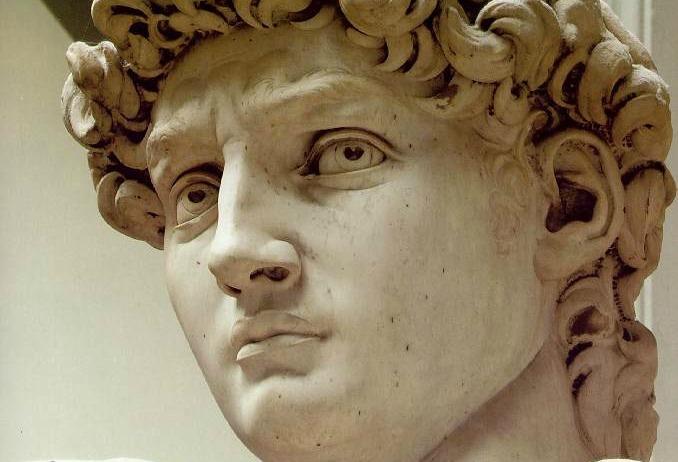It would be easier to study the copy in Piazza della Signoria, the statue’s original position, but this was not sculpted by the ‘Divine One’, and is, after all, just a copy. To truly appreciate the creator and the creation, stubbornly stay in line and think of Giorgio Vasari’s quote: ‘Anyone who has seen Michelangelo’s David has no need to see anything else by another sculptor, living or dead’.
Anguish of creation
At the time of the David commission in 1501, Michelangelo Buonarroti was caught in a tornado of personal torment. The clash between his devotion to God and the handsome pagan men he depicted was central to his struggle.
At the age of 26, the David commission would further provoke this personal anguish, culminating in an image of the world’s most famous naked man and an immortal work of art. The commission to create an Old Testament figure to adorn the buttresses of Florence Cathedral dated back to 1464.
Sculptors had tried, and failed, to bring a massive block of marble to life. It was a seemingly impossible task. But the dormant block, for so long waiting to be cast into history’s dustbin, was about to receive the first hammer-blow of a genius.
A man posessed
 For three years Michelangelo worked in secrecy, often sleeping fully clothed so he could continue his work upon waking. Using three grades of chisel and a rasp, he worked at a frenzied pace, as though his very life depended on it. His reputation certainly did, for Michelangelo was mindful that a successful creation could enhance his reputation as conqueror of the Renaissance.
For three years Michelangelo worked in secrecy, often sleeping fully clothed so he could continue his work upon waking. Using three grades of chisel and a rasp, he worked at a frenzied pace, as though his very life depended on it. His reputation certainly did, for Michelangelo was mindful that a successful creation could enhance his reputation as conqueror of the Renaissance.
Failure would mean his inclusion on the list of artists already defeated by the giant block. Leonardo da Vinci gave a possibly critical description of his younger rival at work. ‘He looks like a baker. The marble dust flours all over him and his back is covered with a snowstorm of chips.’ With scaffolding surrounding the block, Michelangelo would never have seen the statue in its entirety, adding to the brilliance of his achievement. But what was he creating?
Little is certain about Michelangelo’s preparatory works for the David, but the narrowness of the block that limited his options may have assisted in creating something unique. Images of David nearly always featured the Israelite after defeating the giant, with Goliath’s head under foot. Michelangelo would depict his David prior to the conflict with Goliath, thus also symbolically representing Florence, as the young nude male with a mere sling for armoury, sizes up a fearsome, larger opponent.
Enduring masterpiece
 The reclusive three years of dedication came to an end in September 1504 when, for the first time, Michelangelo unveiled his masterpiece to Florence. It was immediately apparent that a statue of such grandeur would be wasted high up on the buttresses of the Duomo.
The reclusive three years of dedication came to an end in September 1504 when, for the first time, Michelangelo unveiled his masterpiece to Florence. It was immediately apparent that a statue of such grandeur would be wasted high up on the buttresses of the Duomo.
The intensity of David’s glare onto approaching danger, the detail of veins, muscle, and bone, and ultimately the ironic size of the figure, would not have been visible from such an elevated position. The statue was instantly viewed as a remarkable achievement and a powerful symbol. Look into David’s fixed eyes and imagine you are Goliath. Are you so certain of victory now?
The statue was granted a place in the prestigious setting of Piazza della Signoria where a copy now stands. Florence placed the statue in a position that allowed David to fearlessly look south toward the notable giant of Rome.
And what of Michelangelo? Well the tornado would take him, at least momentarily, to Paradise. Knowing that he would never have children, Michelangelo viewed his work as his off-spring: ‘My sculptures are my children. And they will live for much longer.’ Five hundred years later, the Israelite still lives.
The method
Michelangelo’s methods remain open to conjecture, but it is possible that he would have created a clay model of David, submerged it in a bath and slowly allowed the water to drain away, thus imitating the removal of marble so he would know what to carve next. Whatever his calculations and methods were, they were integral to his success.
Dealing with the critics
 There were no detractors, although the sponsor of the project, Piero Soderini did make a suggestion that was slyly dealt with by Michelangelo. Soderini, commented that David’s nose was too thick so Michelangelo climbed the scaffolding to attend to the problem.
There were no detractors, although the sponsor of the project, Piero Soderini did make a suggestion that was slyly dealt with by Michelangelo. Soderini, commented that David’s nose was too thick so Michelangelo climbed the scaffolding to attend to the problem.
The young sculptor pretended to alter the nose and even sprinkled marble dust to complete the effect. Michelangelo then asked Soderini’s for his opinion of the ‘new’ nose. ‘Ah, that’s much better,’, said Soderini. ‘Now you’ve really brought it to life.’
The great rivals
Only Leonardo da Vinci, who would reveal Mona Lisa in the same year, could compete with the status of the Florentine. Intriguingly, Leonardo da Vinci, who sat on the panel to discuss the positioning of the statue, suggested David be located in the more inconspicuous position of Loggia dei Lanzi. The two big hitters of the Renaissance were not close, and in one recorded incident Michelangelo ended an exchange with a hurl of artistic insults.









